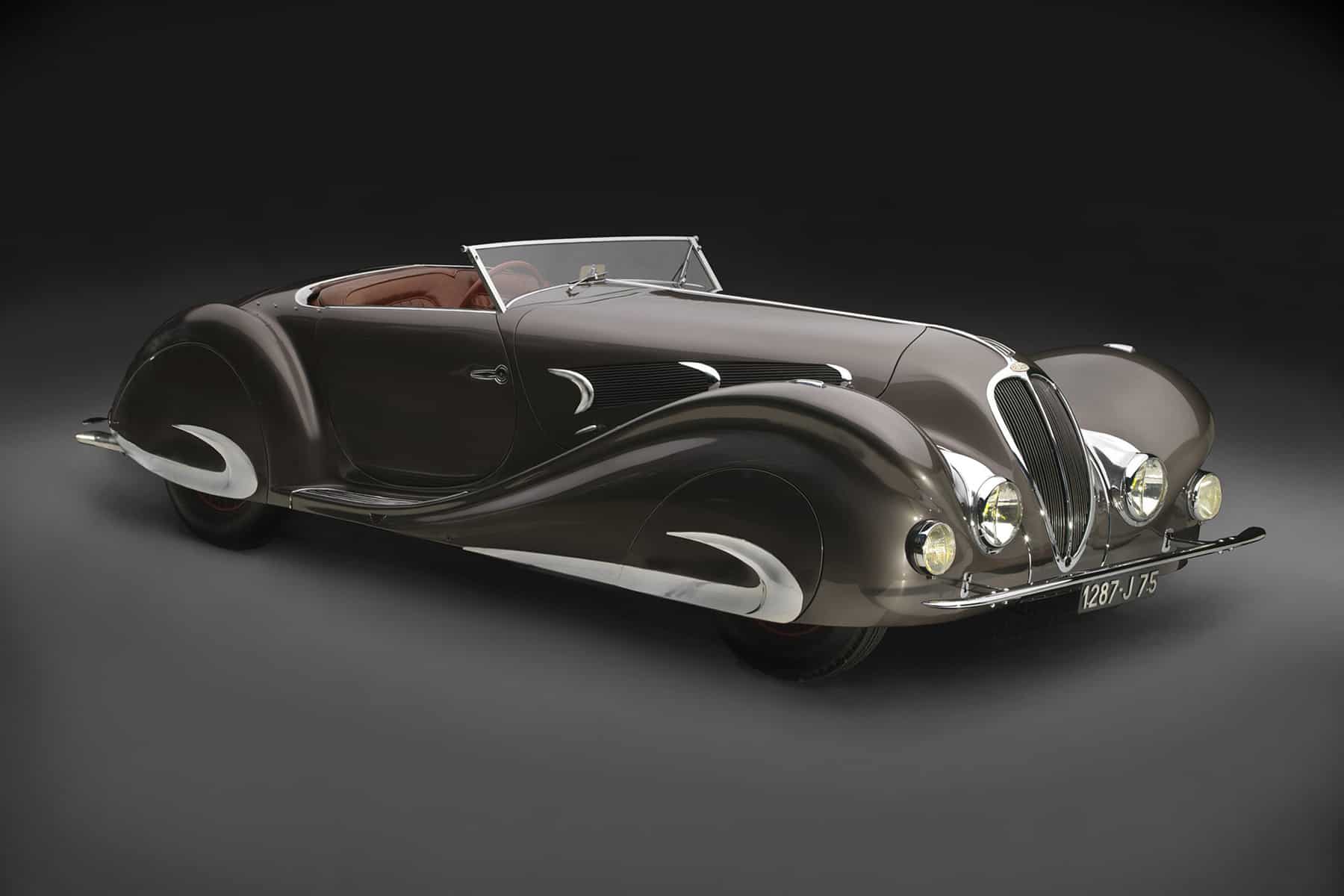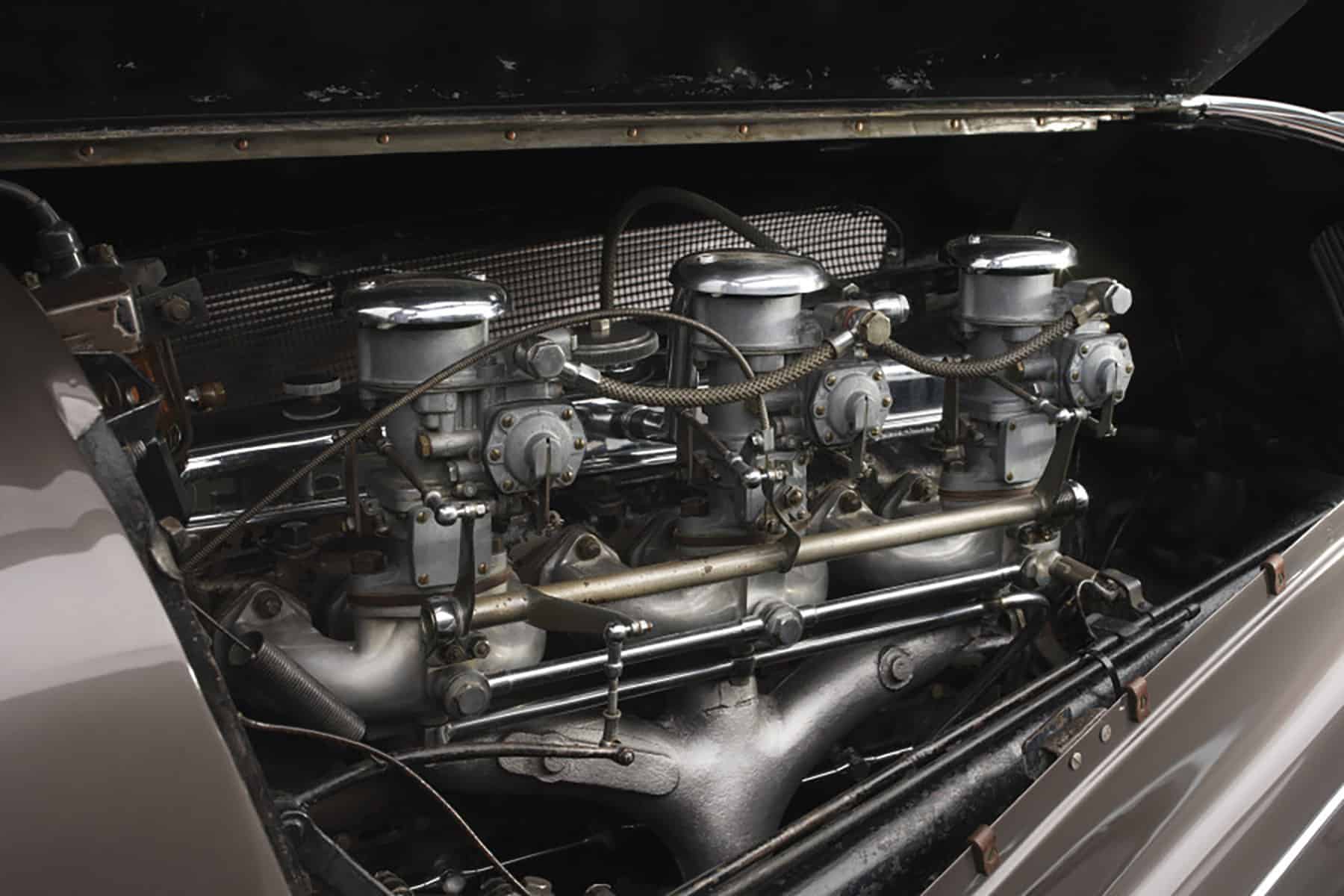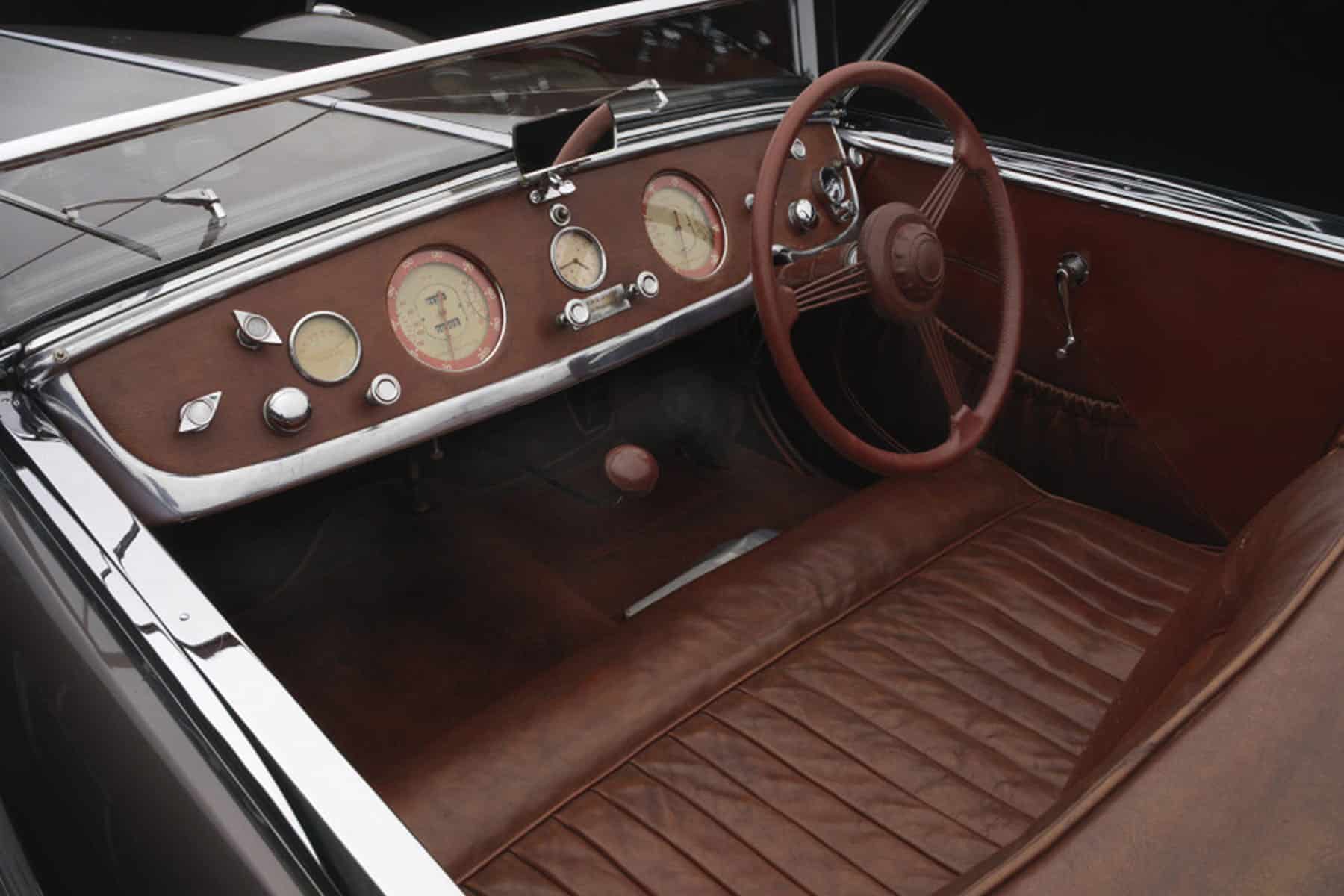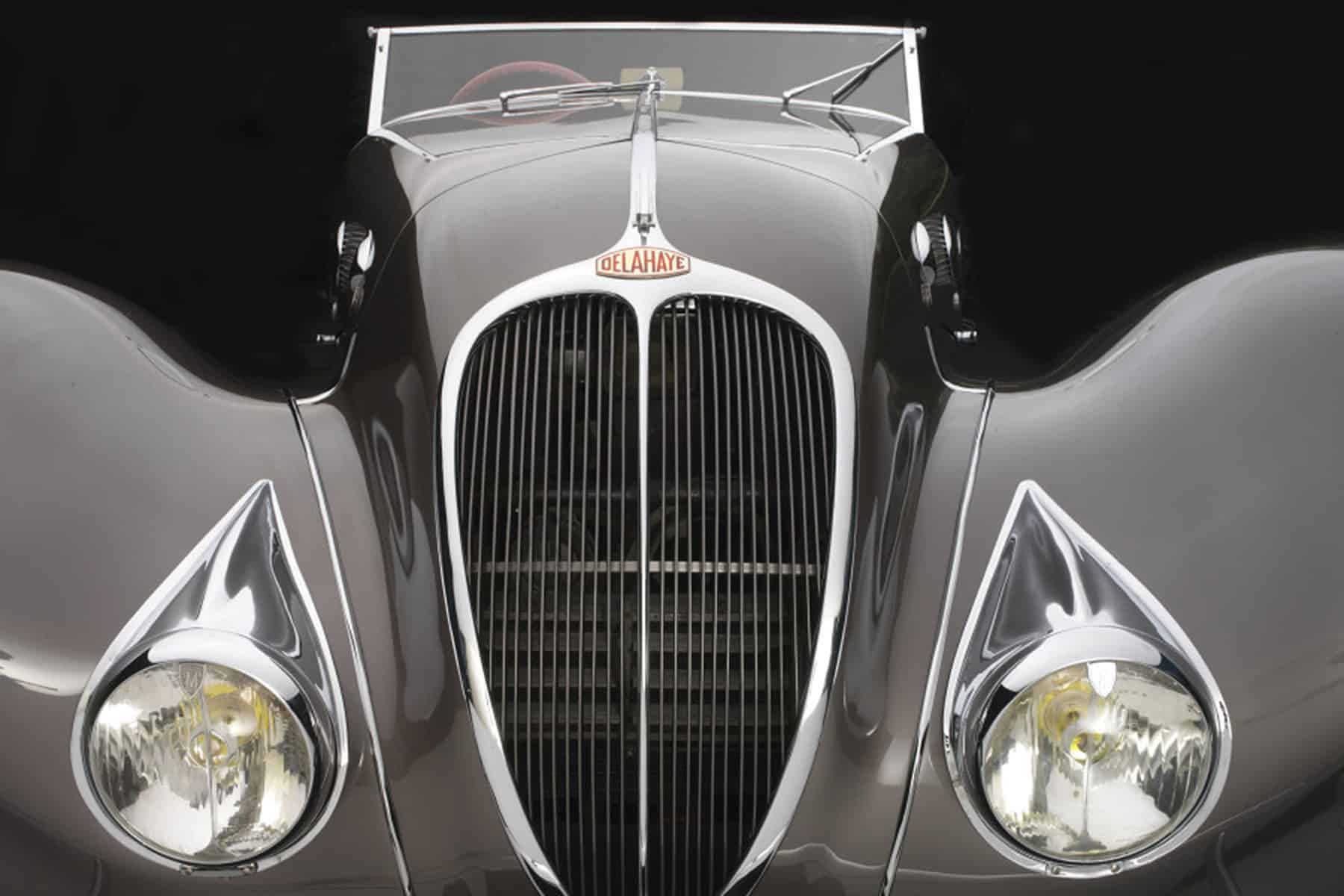
1937 Delahaye Type 135 Competition Court Roadster
“A Paris Gown on Wheels”
BY: KEN GROSS
WITH DRIVING IMPRESSIONS BY MILES C. COLLIER
PHOTOS: PETER HARHOLDT
By mid-1930, even as the Great Depression subsided in Europe, war clouds darkened the horizon. Despite the uncertainty, a few wealthy and optimistic socialites, with money to burn, ordered lavish, bespoke cars with sleek, streamlined coachwork. Expensive then and priceless now, these fantasy-borne confections are considered art-deco rolling sculpture. Their creators, Italian-born émigrés Joseph Figoni and his business partner, Ovidio Falaschi, were shining stars amidst a coterie of Parisian custom coachbuilders whose handiwork has withstood the test of time.
Many of these stunning cars would be shown at posh Concours d’Elegance events in the Bois du Boulogne and other tony venues. The coachbuilders (carrossiers) often collaborated with premier couturiers like Coco Chanel and Jeanne Lanvin, who would create a smashing ensemble to be worn by a lady who’d present the car, in the hope of receiving an award.

The process to create such a car could take six months or more. Committed clients would review proposed sketches. After approval, the construction process would begin with narrow iron straps attached to a production chassis, outlining the shape of the new body. Coachwork proceeded from this maquette, as the atelier’s artisans carefully hand-formed the aluminum panels that would constitute the body shape. Some 2,200 hours were needed to fabricate and complete a handcrafted body. Often Figoni and Falaschi would build a custom creation “on spec,” and display it at a Concours or a major auto show to encourage orders.
In 1936, at the annual Paris Salon, Delahaye displayed a swoopy 135M roadster, chassis number 46756, by Carrosserie Figoni & Falaschi. Admired by a notorious playboy, Prince Ali Salman Aga Khan, who loved fast, flashy cars and equally attractive women, it was purchased right from the show stand. The Aga Khan, as he was known, was married at the time to the American film star, Rita Hayworth.

That roadster’s notoriety inspired this one-off successor, chassis number 48563, built a year later, especially for the 1937 Paris Auto Salon. Shortly before, driven by a liveried chauffeur, it had been presented by Madame Figoni at the August Concours d’Elégance du Gardenia at Saint-Cloud. The roadster’s svelte, hand crafted body, with its fully enclosed front and rear fenders, was mated to a sporty “short” 2.7-meter Delahaye competition chassis. Its luscious dark red leather interior and matching carpets were crafted by Hermès. Indisputably the star of the Salon, it drew constant crowds.
French coachwork authority, Richard Adatto, author of From Passion to Perfection, The Story of French Streamlined Styling, noted “this new evolution took modern streamlining to the next level, by allowing the shape of the coachwork to dictate the (car’s) styling. Instead of separate pontoon fenders that protruded from the car’s body, Figoni found a way to incorporate them into the body, heightening the impression of a singular, flowing form. Using Art Deco ornamentation, he punctuated the car’s hood with scalloped chrome trim that accentuated the curves of the fenders. The effect of the design is that the car appears to be moving, when it’s standing still.”

Dramatic styling aside, the ingenuity behind this car’s complex construction resulted in four new French patents: 827640, for the aerodynamic design that stabilized the front fenders; 800427, for the crank-down disappearing windshield; 800723, for the special lightweight competition tubular seats; and 801728, for the disappearing convertible top. Photos from the 1937 Paris Salon show a driving light centered in the grille. Mounted flush with the body surface, elliptical door handles enhanced the roadster’s modern appearance. No bumpers detracted from its flowing lines. Practicality and safety had never been considerations. This car was always about striking, memorable beauty.
Adatto further researched the car’s history. “Mr. Jean-Pierre Bernard, who was general manager of Delahaye in the 1950s, has fond memories of visiting this car at the home of its then owner, Mr. Roland Poncet. ‘Such a beautiful car,’ Mr. Bernard wrote, ‘must have a story, and this one has quite a lot to tell. We went one sunny afternoon to see her hideaway in Normandy, 80 kms from Paris. Mr. Poncet had specially built a garage to hide this unique piece.’ Right after the 1937 Paris Auto Salon, ‘she was bought by the Ambassador of Brazil during this wonderful period when even serious people such as Ambassadors could show themselves in a fancy car. Times have changed!’”
In an effort to render the Delahaye somewhat more practical, it was returned to Figoni & Falaschi, where the odd central headlight was removed. Slender front and rear bumpers were installed to protect the car from daily driving hazards. “The Ambassador,” continued Mr. Bernard, “kept the car until 1939 when World War II broke out. At that point, it had apparently been driven for less than 1,000 kms. A Frenchman bought it and stored it away somewhere on the Côte d’Azure, until an Italian army officer found it and took it to use as some sort of jeep. When the fortunes of war started to turn against him, the Italian fled home with the car, which the owner was able to find in Milan in 1947. (It was) not an easy thing to hide such an original piece!”
Inevitably, the authorities became involved. The roadster was impounded by French Customs for nearly a year. After its release, it was refreshed at the Figoni workshops, with help from Delahaye.
In 1949, according to Richard Adatto, Chassis 48563 was sold to a Mr. Hanselin, who registered it in Paris and repainted it in Bugatti blue. When he sold the car to Mr. Jean-François Charton, the odometer read only 5,200 km. Charton repainted the roadster ivory in 1978. In October 2001, he sold it to Miles Collier. It had been driven a mere 8,030 km (less than 5,000 miles). Mr. Collier and his team carefully conserved the Delahaye, keeping everything as original as possible, after which it was displayed, still in ivory, in the Preservation Class at the Pebble Beach Concours d’Elegance. After a small section of the original copper/bronze finish was found, the car was repainted to match its appearance at the Paris Salon. It was subsequently displayed in Art Deco exhibitions at the Frist Museum in Nashville and the Museum of Art Houston.

The Figoni Delahaye remains one of the highlights of the Miles Collier Collections in Naples, FL, and Miles Collier kindly consented to describe what it’s like to own and drive:
“Automobiles have a practical, transportation side and a cosmetic, social signaling side. The signals being given off can range from statements of colorless thrift and moral probity to the most exhibitionistic hedonism. As we approach the Figoni et Falaschi–bodied Delahaye roadster, it’s pretty easy to see on which side of the line it falls. Looking like a cross between a Star Wars-inspired hovercraft and some exotic pre-Cambrian life form, this car is nothing if not noticeable.
“That property of uninhibited display is so central to this machine that it dominates the driving experience. There is no question that you are the center of attention as you waft along, six cylinders burbling mellifluously. The wind plays with your $150 razor cut as it rolls over the windshield which you can crank up for more protection, or down to unleash your inner Aga Khan-wanna-be.
“Behind the large diameter, leather steering wheel covered by Hermes, you realize that this confection is the automotive equivalent of the late 19th century Parisian man-about-town of independent means, the flaneur. Seen and remarked upon everywhere, he appears at all the places where seeing and being seen is, well, de rigeur. This thing, the 135 Competition Court roadster, is a flaneur of the road.
“Frankly, who cares how fast it is, though for the standard of the day it’s not bad, with plenty of torque that can be utilized by a whippy flick of the long, wand-like left-hand shifter. Ride is also reasonable in a time when beam axles and cart spring front suspension was good enough for Ettore Bugatti. The Delahaye’s independent front suspension gives a decently supple ride.
“Not that that will mean much, because the central driving experience is being the focus of all eyes from all directions all the time. Do not plan on being anyplace you’re not supposed to be when driving this car. Beware of the driver that pulls up next to you on the road and then, because they are goggling at the Delahaye, drifts out of their lane and into yours.
“Because this car is based on Delahaye’s racing short wheel-base chassis – that’s the competition court or “short” part of the name – it has more performance chops than you first expect. Even so, the bulbous Figoni coachwork makes fast driving a bit chancy, but this car is for owners who clip coupons not apexes.
“No, this car is for an owner who views driving as a theatrical performance, adopting the proper air of bored insouciance at a red-light while being ogled by drivers and pedestrians alike. One needs to be the master of superior forms of repartee. So, while the Figoni et Falaschi Delahaye won’t necessarily make you a better driver,” Collier concludes, “it will sharpen your badinage no end.”




